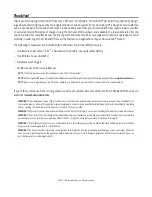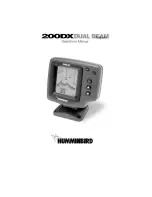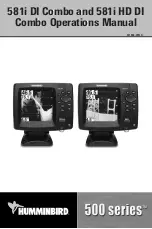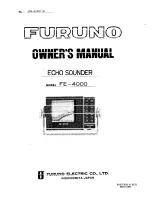
Channel A and B RSS Units
There are two versions of the RSS that are available at your local tackle dealer, major outdoor retailers, or at
www.hummin-
bird.com
: Channel A and Channel B.
The
Channel A
RSS unit comes standard with the WSL Accessory. You also have the option to purchase additional Channel
A or Channel B RSS units. When using the A or B version of the RSS, make sure to select the appropriate channel in the
Channel menu choice from the WSL Accessory Submenu on the control head.
The
A&B Channel Option
gives you the flexibility to use a different type of RSS than the one you are currently using if
another angler is using a SmartCast product within 100 feet (30 m) of your RSS. Two Channel A or two Channel B RSS units
in the water within 100 feet (30 m) of the display will cause RF interference that prevents the product from functioning
properly, resulting in fluctuating depth readings and excessive clutter on the screen. If you use a Channel B RSS while
another angler is using a Channel A RSS or vice versa, the interference will be reduced but not completely eliminated.
NOTE:
RSS units, regardless of Channel, either in close proximity to each other or to other sonar devices (closer than 40 feet or 12 m) can
also experience or cause sonar interference, which may result in erratic depth readings.
Maintenance
Your WSL Accessory is designed to provide years of trouble-free operation with virtually no maintenance. Follow these sim-
ple procedures to ensure your WSL continues to deliver top performance.
If the WSL comes into contact with salt spray, wipe the affected surfaces with a cloth dampened with fresh water.
After using the RSS in salt water, wipe the affected surfaces with a cloth dampened with fresh water. The RSS Wet Switch™
pins must be rinsed with fresh water after exposure to salt water to prevent corrosion.
If your RSS remains out of the water for a long period of time, it may take some time to wet it when returned to the water.
Small air bubbles can cling to the surface of the RSS and interfere with proper operation. Wipe the face of the RSS with a
wet cloth to remove them.
If sonar performance becomes weak (i.e., there are bottom gaps or "0" depth readings) the bottom of the RSS
needs to be cleaned with a drop or two of a 5 to 10 percent solution of liquid dishwashing detergent and water. Use
approximately one tablespoon (15 ml) detergent to 8 ounces (237 ml) of water to remove oils from the face of the
RSS, then wipe with a damp cloth.
Never leave the WSL or RSS in a closed car or trunk - the extremely high temperatures generated in hot weather can dam-
age the electronics.

















